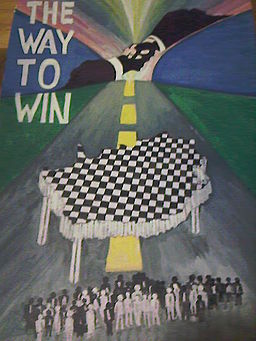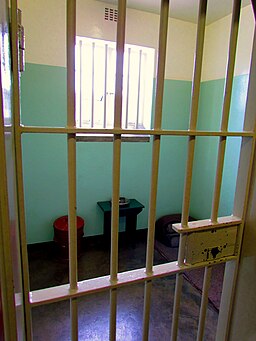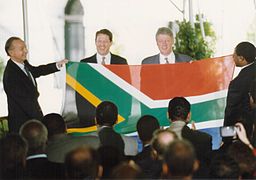
This story takes place in South Africa during apartheid.
The main character, Nadeli, struggles internally between staying quiet to ensure safety for her family, or speaking out against the removal of her community to new "homelands".
She realizes that at a certain point, one can never create true change if they live in constant fear of the consequences.
Motivated to take action by her friend, Taolo, she stands up to her headmaster at school for the children's rights to congregate in the school yard. In awe of her bravery, the student body elects Nadeli as one of the five representatives to lead the school in their resistance movement against apartheid.
Essential Questions:
-
Is separate actually equal?
-
How can a group of children make a difference?
-
What does it take to create change?
-
Can there be change without sacrifice?
-
Why is the metaphor "chain of fire" suitable to describe Nadell's community?
Enduring Understandings:
-
Students will understand the importance of standing up for what they believe in as well as doing what they know is right even in the face of adversity.
-
Students will understand the power that children's voices have to affect change
-
Students will understand the importance of family and community to help weather hardships and support one another in times of fear and change
-
Students will have a better understanding of what apartheid was as well as what it was like to be a kid growing up in that time in South Africa and the sacrifices and hardships they had to deal with and conquer at a young age.
Themes:
- Standing up to versus running from fear
- Sacrifice for a cause
- The power of a child's voice to affect change
- Fear of the unknown
- Cruelties of apartheid
- The challenges of being a leader
- Preservation of cultural identity during colonization
- The kindness of a community and the value of their support
Beverley Naidoo
Learn more about the author! She grew up in South Africa during Apartheid and as a young white woman, she recognized the horrible atrocities going on around her. After she was exiled to England, she began writing about her experiences. Listen to her interviews, look into the FAQ, see pictures from her childhood, and read about her current work on this site.
http://beverleynaidoo.com/biog.htm
 |
| Negotiations to End Apartheid, Magda Macaskill, 1990 |
Begin by asking students what they know about apartheid. Brainstorm a list. Come up with remaining questions and identify holes in your understanding together as a group. Try using the weKWL app. Then offer students pre-approved sites to explore for more information.
http://www.pbs.org/wgbh/masterpiece/endgame/timeline.html
http://overcomingapartheid.msu.edu/people.php?id=65-251-7D
http://www.bbc.co.uk/archive/apartheid/
http://mlk-kpp01.stanford.edu/index.php/encyclopedia/encyclopedia/enc_apartheid_1948_1994/
http://www-cs-students.stanford.edu/~cale/cs201/apartheid.hist.html very good visual chart at the bottom of the page
 The Day Gogo went to Vote
The Day Gogo went to Vote
http://www.amazon.com/Day-Gogo-Went-Vote/dp/0316702714/ref=sr_1_1?s=books&ie=UTF8&qid=1299191452&sr=1-1
.png) Maya Angelou's poem for Nelson Mandela
Maya Angelou's poem for Nelson Mandela
http://www.democracynow.org/2013/12/10/poet_maya_angelous_tribute_to_nelson
Map of bantustans in South Africa at the end of the apartheid period, before they were reincorporated into South Africa proper. By Htonl

Use this map with students to show where the novel takes place as well as where Naledi and her fellow neighbors are being forced into their new "homelands"
South Africa's 11 Official languages and maps of where they are most commonly spoken.
- Tswana (Setswana is the language of the main characters), Zulu (the language of Nadeli's teacher), and Sotho (Sesotho in this link) are language we see in the book.
- Have students track the names of the different languages while they read. Create a running list in the classroom.
http://srufaculty.sru.edu/james.hathaway/rainbow/11_official_languages.htm
Before reading:
Identify sources of conflict that are causing people to stand up for what they believe in on a global scale as well as within your community today. Discuss the obstacles people face as they work towards a resolution for these problems.
During reading:
Brainstorm with your class issues that students their age are fighting for. Thinking of Nadeli and Taolo, what could your students do to take action? How could we incorporate the whole class in accomplishing one goal. Predict some of the problems and obstacles that might pop up.
After reading:
Compare your experience fighting for a cause to Nadeli's. Think about your peers, parents, environment, economical, social, and political differences.**
 |
| Image attributed to Nicolas Mollet and Matthias Stasiak |
 Chain of Fire close reading.docx
Chain of Fire close reading.docx
 Chain of Fire open response.docx
Chain of Fire open response.docx
Standing up for what's right, even when there are consequences.

The most infamous person who come out of the anti-apartheid movement was Nelson Mandela. On this timeline we see the major events in his life and how at many times he was punished for his activism and what he stood for. He is the perfect example of someone who stands up against injustice and does not give up despite the consequences he had to face, including 27 years in prison.
 |
| Nelson Mandela's prison cell on Robben Island, 1964-1982 |
 Chain of Fire Final Essay Questions.docx
Chain of Fire Final Essay Questions.docx
Despite being inside prison, racism was still taking place inside Robben Island. Prisoners were placed in cells according to their race and there were also differences in what the different groups were given to eat. Section C--the place allocated for black South Africans were given less food at each meal. Less money overall was spent on their overseeing and livelihood as prisoners.
This is also the place where Saul, Taolo's father and a political activist fighting apartheid, spent 10 years in jail.
 |
| Post-apartheid South African flag being unveiled in the US, May 6 1994 |
Watch the PBS video to learn more about Nelson Mandela and his roots
http://www.pbs.org/wgbh/pages/frontline/shows/mandela/
An accessible and succinct description of Mandela's life as well as a picture slide show from Time Magazine's For Kids section
http://www.timeforkids.com/news/nelson-mandela-1918-2013/97361
Comments (0)
You don't have permission to comment on this page.